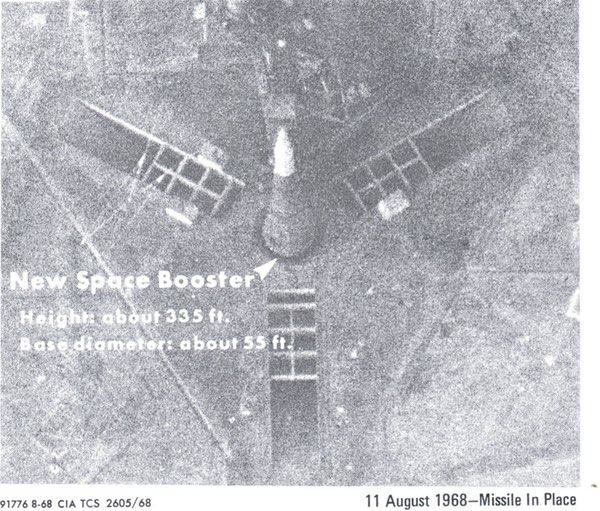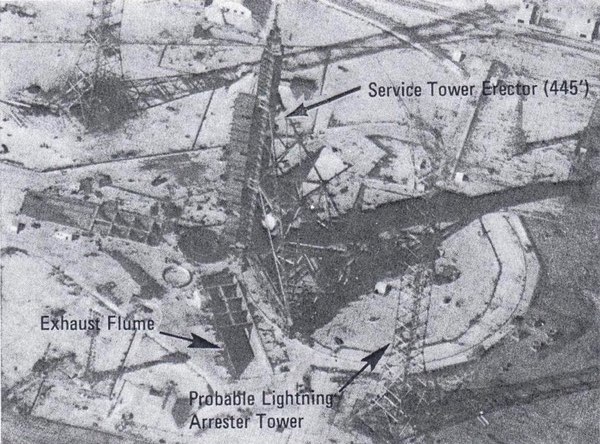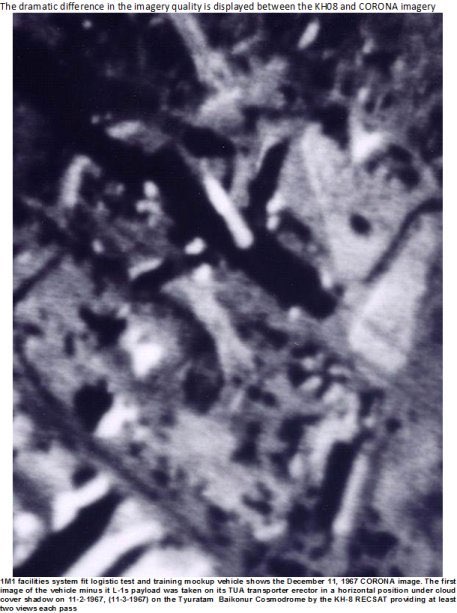|
|
 A declassified image of the Soviet “New Space Booster”, or N-1, from declassified Presidential Daily Briefings. (credit: CIA) |
Dagger of the mind
by Charles Vick and Dwayne Day
Monday, December 19, 2016

Soon after John F. Kennedy announced the plan to send humans to the Moon in the spring of 1961, the Central Intelligence Agency conducted an assessment of the Soviet ability to accomplish the same feat. The CIA had relatively limited intelligence data about Soviet space capabilities, but produced a report stating that there was then no evidence of a similar Soviet goal. The CIA also identified key steps that the Soviets would have to take in order to send cosmonauts to the Moon, and timeline ranges for these steps, thus establishing things that CIA analysts could watch for during the next several years. But until the second half of the 1960s, the data was ambiguous. It was not until 1967 that a US reconnaissance satellite overflew the sprawling Soviet missile and rocket launch facility at Baikonur in Kazakhstan and finally photographed a giant rocket pointing up in the air, like a thorn pointing at the Moon.
Every morning the President of the United States receives an intelligence briefing and a small newsletter known as the President’s Daily Brief (PDB). In early 1966, Lyndon Johnson received a PDB that included a short report on the construction of a big launch complex to support a powerful rocket. The facility had been designated “Complex J” by the CIA, a sequential system that had started with Complex A, the original Sputnik pad. The CIA at that time referred to the overall launch range as “Tyura-Tam” and had first detected construction at Complex J in 1963. In December 1967, the President’s Daily Brief noted that an American satellite had for the first time spotted a large rocket at one of two pads at Complex J. This was a low-resolution photograph taken by a CORONA reconnaissance satellite.
 A March 1968 image of the N-1 pad being constructed. (credit: CIA) |
American satellite reconnaissance capabilities improved substantially during the 1960s, and by August 1968 the President’s Daily Brief included several images taken by high-resolution GAMBIT-3 satellites accompanying reports on Soviet progress. In response to Mandatory Declassification Review requests and PDB declassification requests, those images from the President’s Daily Brief have now been released. Even though these images have been scanned from paper copies and not glossy photographs or original negatives, they are quite impressive in their detail.
One image in the August 1968 report was taken by an American satellite five months earlier, in March, and shows one of the pads nearing completion. The steel latticework in the service tower and the two lightning towers is quite visible. A label indicates that the rocket’s service tower was 445 feet (135.6 meters) tall.
A second image included in the report was less than two weeks old, taken on August 11. The launch facility is covered with haze, which is typical for that area of Kazakhstan that month. Despite the haze, a large rocket is clearly visible on the launch pad, identified as a “New Space Booster” with a height “about 335 feet” (102 meters) and a base diameter “about 55 feet.” (16.8 meters)
 A December 1967 low-resolution CORONA image of the N-1 pad. (credit: CIA) |
By August 1968, Lyndon Johnson was heading for the exit, replaced by Richard Nixon in January. Nixon then started receiving the daily briefs, including updates about the Soviet lunar program. In summer 1969 he was informed about a major explosion involving one of the Soviet large rockets. That story, and the newly declassified imagery, will be covered in a future article.
Charles Vick is a Senior Technical and Space Policy Analyst. Dwayne Day can be reached at zirconic1@cox.net.
|
|


